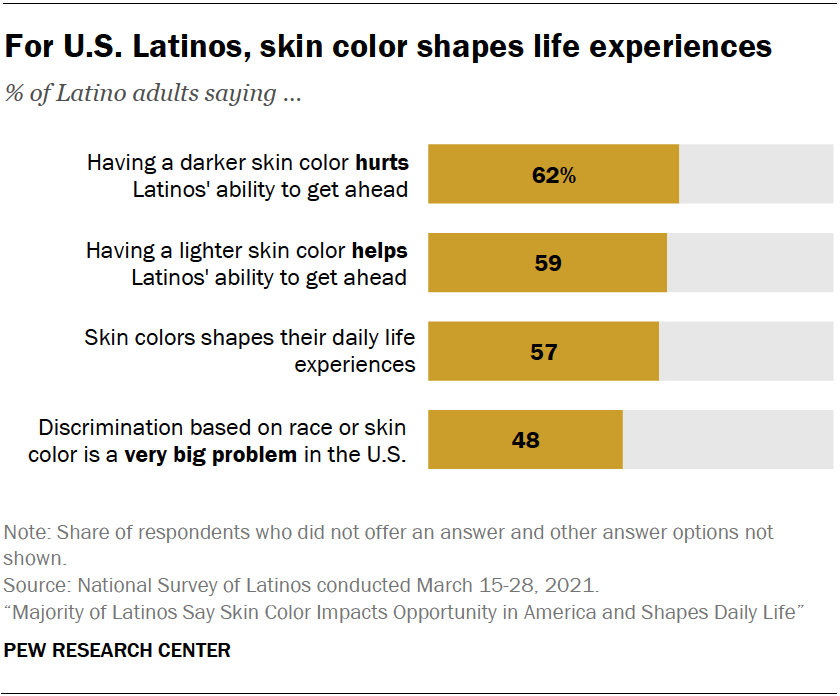Majority of Latinos Say Skin Color Impacts Opportunity in America and Shapes Daily Life |
Majority of Latinos Say Skin Color Impacts Opportunity in America and Shapes Daily Life
Pew Research Center
Washington, D.C.
2021-11-04
63 pages
Latinos with darker skin color report more discrimination experiences than Latinos with lighter skin color
The perceived impact of skin color in the lives of U.S. Latinos is broad. From impacting their ability to get ahead in the country to shaping their daily life experiences to dealing with discrimination, skin color is seen by Latinos as an important factor affecting their lives and life chances.
A majority (62%) of Hispanic adults say having a darker skin color hurts Hispanics’ ability to get ahead in the United States today at least a little. A similar share (59%) say having a lighter skin color helps Hispanics get ahead. And 57% say skin color shapes their daily life experiences a lot or some, with about half saying discrimination based on race or skin color is a “very big problem” in the U.S. today, according to Pew Research Center’s National Survey of Latinos, a bilingual, national survey of 3,375 Hispanic U.S. adults conducted in March 2021.
Colorism is a form of discrimination based on skin color, usually, though not always, favoring lighter skin color over darker skin color within a racial or ethnic group. While it can be tied to racism, it is not necessarily the same. (Racism is prejudice directed at members of a racial or ethnic group because of their origin.) For example, Hispanics in the U.S. may face discrimination because they are Hispanic (a form of racism), but the degree of discrimination may vary based on skin color, with those of darker shades experiencing more incidents (a form of colorism). And because of colorism’s deep roots in the histories of Latin America and the United States, discrimination based on skin color can occur among Hispanics just as much as it can be directed at Hispanics by non-Hispanics.
To measure this dimension of Latino identity in the United States, the survey asked respondents to identify the skin color that best resembled their own using a version of the Yadon-Ostfeld skin-color scale. Respondents were shown ten skin colors that ranged from fair to dark (see text box below for the images and scale used). Fully 80% of Latino adults selected a color between one and four, or lighter skin colors, while 15% selected a color between five and ten on the scale, or darker skin colors.1…
Table of Contents
- Majority of Latinos Say Skin Color Impacts Opportunity in America and Shapes Daily Life
- Discrimination and skin color
- Impact of race, skin color is a topic of conversation with relatives and friends for Hispanics
- Half of Latinos say there is too little national attention on racial issues concerning Latino people
- Hispanics often hear other Hispanics make racially insensitive comments and jokes about Hispanics and non-Hispanics alike
- While Hispanics say skin color affects their ability to get ahead in America, other factors are seen as important as well
- For Latinos, discrimination experiences and views about skin color and race are linked
- 1. Half of U.S Latinos experienced some form of discrimination during the first year of the pandemic
- 2. For many Latinos, skin color shapes their daily life and affects opportunity in America
- 3. Latinos divided on whether race gets too much or too little attention in the U.S. today
- 4. Measuring the racial identity of Latinos
- Acknowledgments
- Methodology
- Appendix: Additional tables
Read the entire report in PDF or HTML format.
Tags: colorism, Pew Research Center, Pew Research Center’s National Survey of Latinos